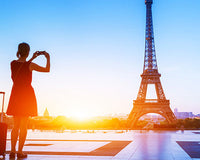Berlin, the capital of Germany, is a city that never leaves anyone indifferent. Deeply rooted in its history yet turned toward modernity and tourism, it offers a unique atmosphere in Europe. Marked by major events such as World War II and the Cold War, the city has successfully reinvented itself into a creative and dynamic metropolis.
It’s a destination that attracts both history and culture enthusiasts as well as lovers of contemporary art, nightlife, and culinary discoveries. Preparing a trip to Berlin means embracing a city of many faces, where every neighborhood has its own distinctive character.
Whether you want to admire iconic landmarks, explore world-renowned museums, discover alternative districts, or enjoy local cuisine, Berlin always has something fascinating to see or do. In this guide, we’ll take you through the must-see attractions and share practical tips to make the most of your stay.
Must-See Attractions in Berlin
A trip to Berlin isn’t complete without discovering its most emblematic landmarks and symbolic sites.

Brandenburg Gate
Located on Pariser Platz, the Brandenburg Gate is undoubtedly Berlin’s most famous monument. Built at the end of the 18th century, it has witnessed many major events in German history. Once a symbol of division during the Cold War, it became a powerful emblem of reunification after 1989.
Today, it’s a must-visit spot for travelers, both day and night. Illuminated after sunset, it exudes a special aura, making it one of the most photographed sites in Germany.
The Reichstag and Its Glass Dome
Another major landmark, the Reichstag houses the German Parliament. Its impressive architecture combines neo-Renaissance style with modern design, reflecting its significance in the nation’s political history. The glass dome, designed by Norman Foster, has become an attraction in its own right.
Visitors can climb to the top free of charge for a stunning panoramic view of Berlin and an exhibition about the Bundestag’s role. Advance reservations are highly recommended, as spots are limited and in high demand.
The Berlin Wall and the East Side Gallery
Built in 1961, the Berlin Wall divided the city for nearly 30 years. Today, several sections remain, but the most famous is the East Side Gallery, a 1.3 km stretch transformed into an open-air art gallery.
Over 100 artists from around the world have painted murals here, including the famous “Fraternal Kiss” between Brezhnev and Honecker. The site is both a moving historical testimony and a vibrant expression of regained freedom.
Museums and Historical Sites
Berlin is home to countless museums and memorials that offer deep insight into its turbulent past.

Museum Island
In the heart of the Spree River lies Museum Island, a UNESCO World Heritage site. Five world-class museums are gathered here, forming one of the most important cultural complexes in Europe. The Pergamon Museum is particularly impressive, with its vast archaeological collections and monumental reconstructions such as the Pergamon Altar and the Ishtar Gate. The Neues Museum, meanwhile, houses the famous bust of Nefertiti.
You can easily spend an entire day exploring this unique site. A combined ticket costs around €19, making it excellent value for art and history lovers.
The Holocaust Memorial
Located near the Brandenburg Gate, the Memorial to the Murdered Jews of Europe is a must-visit for anyone wishing to reflect on the tragedies of the 20th century. Designed by architect Peter Eisenman, it consists of 2,711 concrete slabs of varying heights, arranged to create a haunting and contemplative atmosphere.
The site encourages reflection and remembrance. Beneath the memorial, an information center documents the persecution and extermination of European Jews. Admission is free, allowing everyone to visit and pay their respects.
Checkpoint Charlie and the Wall Museum
Among the Cold War relics, Checkpoint Charlie remains one of the most emblematic sites. Once a border crossing between East and West Berlin, it symbolized the division of the city. Today, a reconstructed guardhouse attracts countless visitors.
The nearby museum recounts the history of the Berlin Wall, the personal tragedies of separated families, and the daring escape attempts. It’s a powerful place that captures the emotional reality of a divided city.
Neighborhoods to Explore
Beyond its monuments, Berlin reveals its true character through its diverse neighborhoods, each with its own charm.
Mitte: The Historic Heart
Mitte is the central district and the historic core of Berlin. Most of the city’s main landmarks are here, including Museum Island and bustling squares such as Alexanderplatz. It’s also a great area for strolling along Unter den Linden, a grand boulevard lined with majestic buildings. Staying in Mitte is convenient for exploring the city on foot and soaking in its cosmopolitan atmosphere.
Kreuzberg: Alternative and Multicultural
Kreuzberg is perhaps the most iconic of Berlin’s alternative neighborhoods. Known for its bohemian and multicultural vibe, it’s filled with street art, independent cafés, and international restaurants.
The Landwehr Canal is particularly pleasant for a summer stroll. Kreuzberg is also a nightlife hotspot, with bars and clubs that stay lively until dawn.
Prenzlauer Berg: Bohemian Chic
Once a working-class neighborhood, Prenzlauer Berg has become a trendy area popular with young families and artists. Its cobbled streets lined with restored buildings, flea markets, and cozy cafés make it perfect for leisurely walks.
Mauerpark, famous for its Sunday flea market and spontaneous open-air concerts, is an absolute must.
Berlin’s Food Scene
Berlin may not have the culinary fame of Paris or Rome, but it offers plenty of delicious surprises.
Local Specialties
Among the city’s most famous dishes, currywurst holds a special place. This grilled sausage topped with curry-flavored tomato sauce is a true Berlin icon. Those seeking something more traditional can try eisbein, a hearty pork knuckle served with sauerkraut and potatoes.
International Cuisine
Berlin’s cultural diversity is reflected in its food scene. You’ll find excellent Turkish eateries serving kebabs and mezze, popular Vietnamese restaurants, and a growing number of vegetarian and vegan options.
For a unique experience, visit Markthalle Neun in Kreuzberg, a covered market where locals and tourists alike gather to enjoy street food from around the world in a friendly setting.
Nightlife in Berlin
Berlin is world-famous for its unparalleled nightlife.
Legendary Clubs
The city’s electronic music scene is legendary. Clubs such as Berghain, often considered the temple of techno, and Watergate, with its panoramic view over the Spree, attract international DJs and partygoers from all over the world. Entry policies can be strict, but for electronic music fans, the experience is unforgettable.
Bars and Alternative Venues
For a more relaxed night out, Berlin has countless creative bars. Some are set in former factories, others on rooftops with stunning city views. Prices are reasonable: a beer usually costs between €4 and €6, making nightlife accessible for all budgets.
Practical Tips for Visiting Berlin
When to Visit
The best times to visit Berlin are spring (April to June) and autumn (September to October), when the weather is pleasant and crowds are smaller. Summer is lively, with festivals and outdoor events, while winter is cold but charming thanks to its Christmas markets and festive atmosphere.
Getting Around
Berlin’s public transportation network is excellent. Between the U-Bahn (subway), S-Bahn (urban trains), trams, and buses, you can get almost anywhere with ease. A day ticket costs around €9.50 and allows unlimited travel across the city. Multi-day passes are available and offer even better value.
Budget
Berlin remains relatively affordable compared to other major European capitals. Accommodation ranges from about €70 per night for a 3-star hotel to over €200 for luxury options. Meals in a standard restaurant cost between €12 and €20, while street food like currywurst or kebabs can be found for under €6.
Berlin: A City of Many Faces
Visiting Berlin means immersing yourself in a city where every street tells a story. From historical landmarks to alternative neighborhoods, and from its rich art scene to its diverse food culture, the German capital captivates with its energy and contrasts. Whether you stay for a weekend or a week, Berlin always offers new discoveries and an atmosphere that makes you want to return.

FAQ: Visiting Berlin
How many days do you need to visit Berlin?
For the main highlights, 3 to 4 days are ideal. That’s enough to visit major landmarks, a few museums, and experience the city’s atmosphere. To explore more deeply, plan about a week.
What is the average daily budget in Berlin?
A budget of €100–150 per day should cover accommodation, meals, transportation, and some activities. Berlin is still more affordable than other European capitals like Paris or London.
Which areas are best to stay in?
Mitte is ideal for first-time visitors, as it’s close to most attractions. Prenzlauer Berg is great for a relaxed, family-friendly vibe, while Kreuzberg suits those who love nightlife and multicultural dining.
What is the best time to visit Berlin?
Spring and autumn are the most pleasant seasons, but summer is great for open-air events. Winter is cold but magical thanks to Christmas markets and cozy cafés.
Is Berlin family-friendly?
Absolutely. Many museums have interactive exhibits for children, the city’s parks are spacious and safe, and public transport is easy to navigate even with a stroller.











